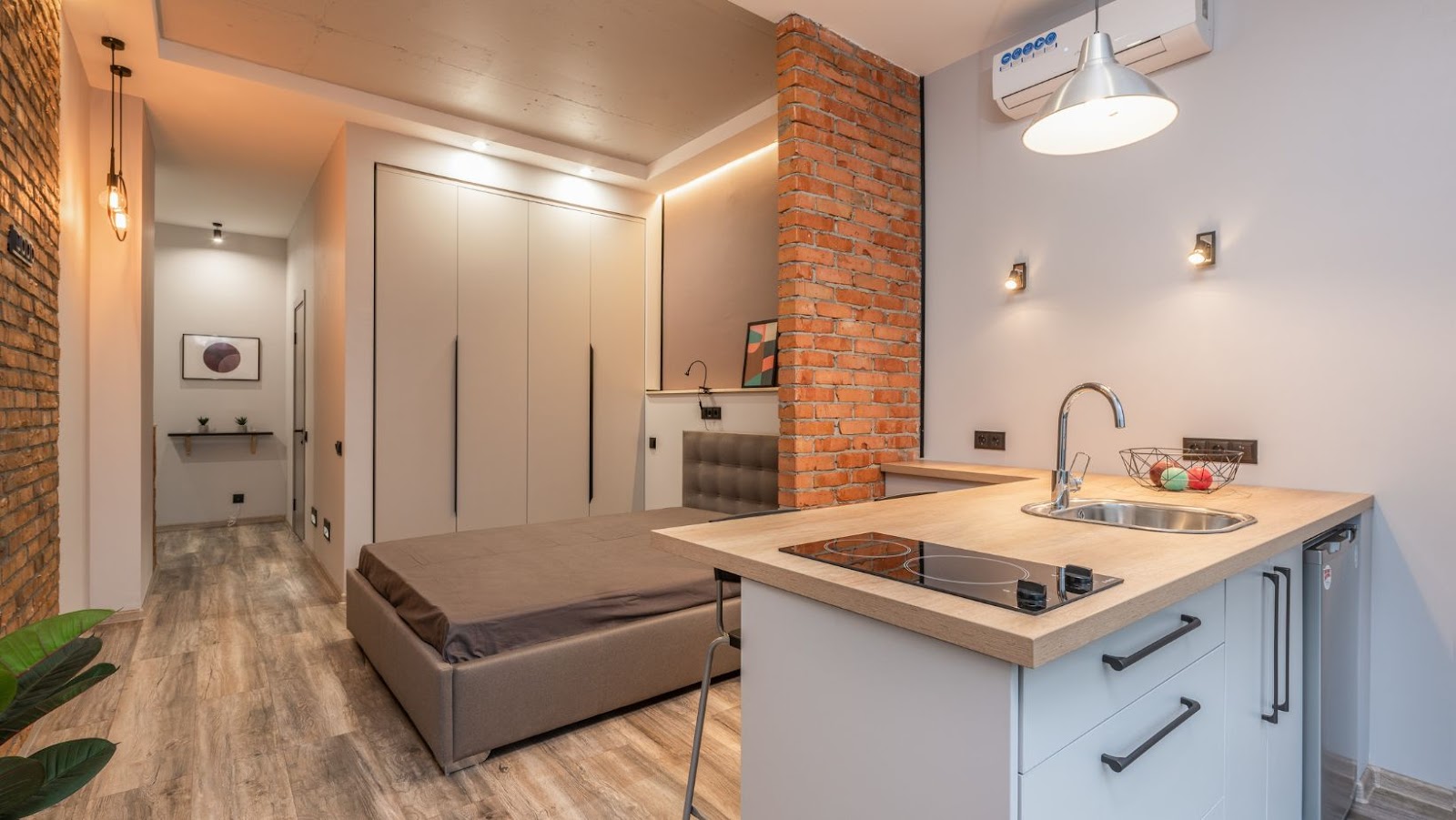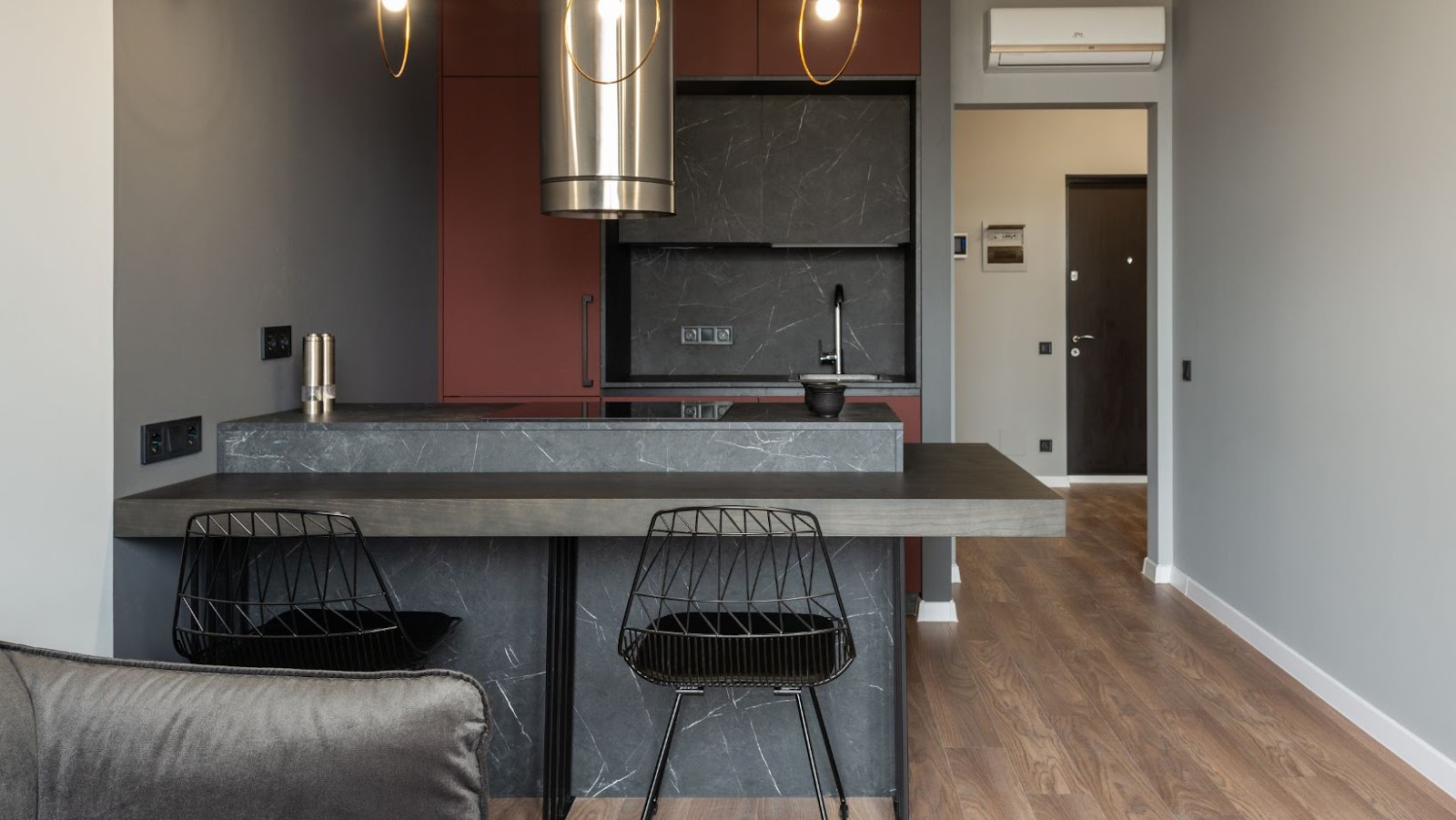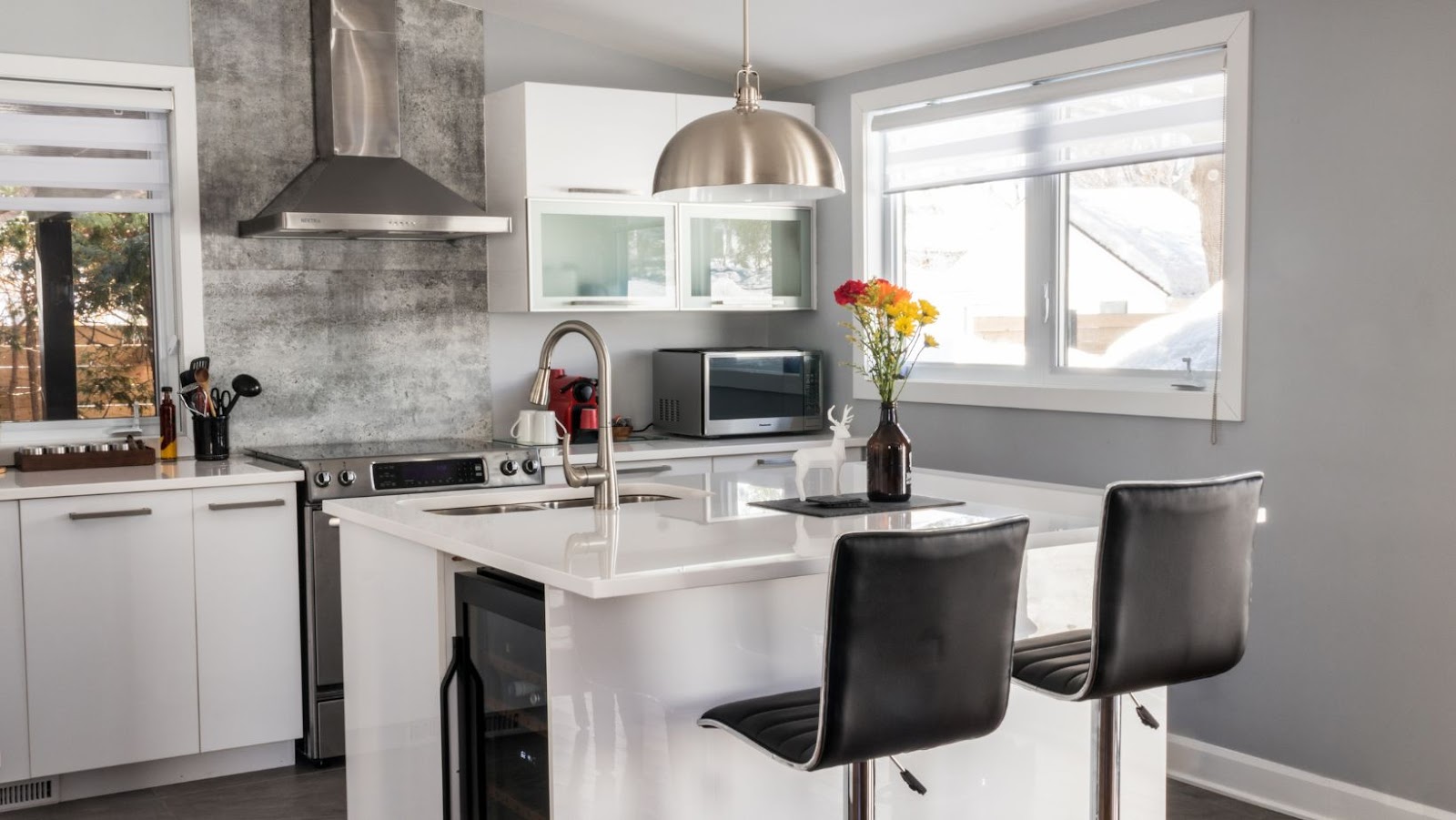Making the most of a small kitchen island is all about maximising functionality while using the available space wisely.
How Wide Is a Kitchen Island
- Keep it proportionate: A small kitchen island should be no wider than four feet, which makes it easy to access all sides and use it for multiple purposes.
- Storage: Incorporate storage space by adding shelves, cabinets, or hooks to store utensils, pots, pans, and other kitchen essentials.
- Seating: If space allows, add bar seating or small stools to provide a comfortable seating area for dining or conversation.
- Multi-purpose: Make use of the countertop by placing cutting boards, mixing bowls, or other kitchen gadgetry on it. Add a sink or a cooktop to further optimise its functionality.
By keeping these tips in mind, anyone can make the most out of a small kitchen island while using it to its maximum potential.
Maximising Space With a Small Kitchen Island
Kitchen islands have become a popular addition to any kitchen – but what if you don’t have a lot of space in your kitchen? Fortunately, you can still make the most of a small kitchen island. The answer is to choose the right size island for your kitchen. Standard kitchen islands are usually about 40-48 inches wide, and for a small kitchen, a kitchen island size of 36 inches is usually the best option. Let’s explore how to make the most of your small kitchen island.
Measuring the Space: How Wide is Your Kitchen Island?
Measuring the space is a critical step when it comes to maximising space with a small kitchen island. Before purchasing or building a kitchen island, it is essential to take accurate measurements of your kitchen space to determine the ideal width, length, and height required for the island.
Here are the steps to follow:
- Measure the distance between the kitchen wall and the cabinets or appliances, ensuring to leave enough space for the island to function effectively.
- Determine the required clearance distance, typically around 42-48 inches, between the island and other kitchen fixtures.
- Consider the length of the island, depending on your needs and the available space.
- Take into account the height of the island, ensuring it aligns with your countertops and cabinetry.
- Finally, ensure that the width of the island is adequate for your purposes, such as food preparation, cooking, storage, and/or seating.
By measuring the space and following these steps, you can build or purchase a small kitchen island that is functional, aesthetically pleasing, and maximises the space available in your kitchen.

Choosing the Perfect Island Size for Your Space
When it comes to choosing the perfect island size for your space, consider the size of your kitchen, your storage needs, and how you plan to use the island. If you have a small kitchen, a compact island can be a great way to maximise your space. It’s important to choose an island that’s wide enough to be functional but doesn’t take up too much space. The average width of a kitchen island is around 3 feet, but it can range from 2 to 4 feet. A width of 2 feet can work if you’re short on space, while a width of 4 feet is ideal if you have a larger kitchen and need more counter space.
When planning the size of your island, consider the clearance around it. You should have at least 36 inches of clearance around the island to allow for easy movement in the kitchen.
Pro Tip: If you’re unsure about the size of your island, use painter’s tape to mark out the area where you plan to place it. This will give you a better idea of how it will fit in your space before making a final decision.
Determining Your Island’s Function and Purpose
Before creating a small kitchen island, you must determine its function and purpose so that it maximises space and serves your needs. The ideal width of a small kitchen island is 2-4 feet as it allows easy movement and storage. The purpose of your island is a crucial deciding factor in choosing the width. If your island is for food prep, a narrow width will suffice. However, if you plan on using the island as a dining area or for entertaining guests, a wider length can be beneficial. Consider the storage and appliances you want to install on the island, and how much room they will take up. Installing a sink or a stove on the island can be a more functional use of space whilst storage boxes can be used as an alternative to manage small objects. Keep in mind your available resources and your specific requirements while determining your island’s function and purpose.
Selecting the Right Island Design
When you are looking to maximise the space in a small kitchen, one of the best options is to add a kitchen island. Kitchen islands come in a variety of sizes, shapes, and designs, and it’s important to select one that fits your space. An important factor in determining the size and shape of the island is the width, so you’ll want to consider how wide of an island you need before you make a purchase.
Incorporating Storage Solutions for Small Spaces
Making the most of a small kitchen island involves selecting the right island design for your space and incorporating storage solutions that maximise functionality while minimising clutter. When selecting the right island design, there are several factors to consider such as the size of your kitchen, your lifestyle, cooking habits, and preferred aesthetic.
For small kitchens, a slim kitchen island with a width of 24 to 30 inches is ideal as it provides workspace and storage without taking up too much space. Islands with built-in storage, such as cabinets and drawers, are also great for maximising storage in a small kitchen. Other features such as drop leaves, open shelves, and towel bars can also provide additional workspace and storage, while adding to the island’s overall functionality.
Remember to keep the island clutter-free and organised by using organisers and racks to ensure everything has its place.
Determining the Best Shape for Your Island
When it comes to determining the best shape for your kitchen island, it’s essential to consider both the available space and your needs. The width is a crucial factor to consider, as it determines how functional your island will be.
Here are a few island shapes to consider:
- L-Shaped Island: A versatile shape, ideal for corner spaces. It is perfect for adding more counter space, storage shelves, or even a small dining area. For comfortable seating, make sure it’s at least 36 inches wide.
- U-Shaped Island: Best suited for large kitchens, this shape provides more storage and work area. It works well for open floor plan homes and can include a cooktop or sink for added functionality. Make sure it’s at least 5 feet wide so that two people can use it easily.
- Rectangular Island: A classic shape that is functional and provides ample storage and counter space. It also supports seating on one or two sides. A minimum width of 24 inches is recommended for this type of island.
- Circular Island: It is best suited for larger kitchens and can act as a centrepiece of the kitchen. However, it can be difficult to design storage effectively in this shape, so make sure to plan well. A 6-foot diameter is recommended for comfortable seating.
When choosing your island, make sure to pick a shape that fits your needs and the size of your kitchen. Additionally, consider the width, as a minimum of 24-36 inches is needed, depending on the shape you select.
Pro tip: To make the most of a small kitchen island, opt for a rectangle-shaped island that allows for easy movement and provides ample storage and counter space.
Choosing the Right Materials for Your Island
Choosing the right materials for your kitchen island can make it both functional and aesthetically pleasing. The materials you choose for your island should be durable, easy to clean, and complement the overall design of your kitchen. Granite, marble, and quartz are popular choices for countertops, as they are heat-resistant, scratch-resistant, and add a touch of elegance to any kitchen. For the base of the island, consider using wood or metal for a sturdy and long-lasting foundation.
When it comes to the size of your island, there is no set-in-stone rule, as it depends on the size of your kitchen and the island’s intended function. As a general guideline, the average kitchen island width is around 3 feet, but it can go up to 6 or 7 feet for larger kitchens.
Pro tip: Make sure to leave enough space between your island and other countertops and appliances to allow for proper traffic flow and comfortable seating.

Optimising Island Function With Proper Placement
Kitchen islands are a great way to add extra storage, countertop space and seating into a small kitchen. However, in order to make the most of a small kitchen island, proper placement needs to be taken into account. The width of a kitchen island is an important factor to consider when trying to optimise its function. In this article, we will discuss different placement ideas that are suitable for kitchen islands of various sizes.
Best Placement for Your Kitchen Island
Proper placement of a kitchen island can significantly optimise its function and enhance the overall aesthetic of your kitchen. The ideal location for your kitchen island depends on multiple factors, such as the size of your kitchen, the layout, and the purpose of the island.
For small kitchens, it’s best to place the island away from the main traffic flow and near the wall to maximise the space. In larger kitchens, the island can act as a divider between the cooking and dining areas.
Another essential aspect to consider is the width of your kitchen island. It should be at least 2 feet wide to allow for comfortable movement and food preparation. For a multi-functional island with seating, an additional 6 to 12 inches should be added per seating space.
With the right placement and size, a kitchen island can serve as an anchor for your kitchen and enhance its functionality and aesthetics.
Creating a Flow in Kitchen Design
Creating a flow in kitchen design is essential for optimising the functionality of your space. One key element of this design is the proper placement and size of your kitchen island. When it comes to small kitchen islands, it’s important to consider the width and positioning to ensure it doesn’t impede the flow.
A good rule of thumb is to leave at least 3 feet of space between the island and other kitchen elements. This allows for comfortable movement around the island without feeling cramped. As for the width of the island, the standard recommendation is 2 feet, but it can vary based on the size of your kitchen and your needs.
To make the most of a small kitchen island, you can incorporate storage solutions like pull-out drawers or shelving underneath, use it as an additional workspace or countertop, or even as a seating area with the addition of stools. By optimising the function of your island, you can improve the overall flow and organisation in your kitchen.
Utilising Island for Task Specific Needs
A kitchen island can serve a multitude of task-specific needs and enhance the overall functionality of your kitchen if placed and utilised correctly. It’s not just about how wide is a kitchen island; it’s also about its placement, size, and purposes it could fulfil.
Consider the following factors while optimising your island function with proper placement:
- Size: The size and shape of your kitchen island depend on your kitchen’s layout and available space. Ensure that it doesn’t overwhelm the space or make traffic flow cumbersome.
- Placement: The kitchen island’s perfect location is facing the work triangle – the sink, fridge, and stove. It should also have ample space around it for you to move easily from one workstation to another.
- Utilisation: The kitchen island’s best function is based on how you plan to use it. It can serve as a storage unit, seating area, cooking station, or a combination of the three.
A small kitchen island can be optimised to serve different functions, such as acting as a breakfast bar, a prep station, or a makeshift pantry. With creativity and resourcefulness, you can create an efficient and functional space irrespective of how wide a kitchen island is.
Creative Design Tips and Tricks
A small kitchen island can be a great addition to your kitchen, but it can be tricky to maximise the space in a limited area. Even though the traditional width of a kitchen island is 48 inches or more, there are plenty of ways to make the most of a small kitchen island with creative design tips and tricks. Let’s explore how to make the most of this space.
Adding Style With Accessories and Decor
In a small kitchen, an island can be a game-changer, both from a functional and aesthetic perspective. Here are some creative design tips and tricks to make the most of your small kitchen island by adding style with accessories and decor. Determine the ideal size of your island based on your kitchen layout and needs. A small kitchen should have an island that is no less than 2 feet wide and 4 feet long.
Enhance the functionality and style of your island by adding the right accessories and decor:
- Install pendant lights above the island to provide task lighting and create visual interest.
- Add stools or chairs for seating to turn the island into a social area.
- Use decorative baskets or crates to store items under the island.
- Display decorative items, such as fresh flowers, cookbooks, or art pieces, on the island to add character and style to the space.
Remember to keep the island clutter-free and only add functional and decorative accessories that fit your style and needs.
Pro tip: A small kitchen island can be a design centrepiece with the right accessories and functionality, maximising the space and adding style to the heart of the home.
Using Lighting to Highlight and Define the Island Space
Proper lighting is an essential design element when it comes to highlighting and defining a small kitchen island.
When planning your kitchen island lighting, consider these tips and tricks:
- Determine the size of your island: Measure the width and length to decide how many lighting fixtures you will need. A general rule of thumb is one fixture for every two feet of island length.
- Choose the right light fixtures: Pendant lights are a popular choice for kitchen islands as they provide ample light and can be hung at varying heights. For a more modern look, consider linear chandeliers or flush-mounted fixtures.
- Position the lights correctly: The lights should be positioned directly above the centre of the island and evenly spaced. The bottom of the fixture should be around 30-36 inches above the island surface.
- Add dimmer switches: Dimmer switches allow you to adjust the light intensity and create different moods for your kitchen.
By implementing these lighting techniques, you can make your small kitchen island not only functional but also visually appealing.
Creating a Seamless Look With Your Existing Kitchen Décor
A small kitchen island can be a functional and stylish addition to your kitchen décor, but it can be challenging to make it look seamlessly integrated into your existing design.
Here are some design tips and tricks to make the most of a small kitchen island:
- Size Matters: The ideal size of a kitchen island should be about 3 feet wide and 5 feet long. This size allows for optimal flow in a kitchen and ensures that the island is functional.
- Blend in Materials: To create a seamless look, make sure that the materials used for your kitchen island match the materials used for the rest of your kitchen. For instance, if you have a granite countertop, your kitchen island should also have a granite countertop.
- Match Colours: Choose a colour scheme that matches the rest of your kitchen for the island. Paint your kitchen island the same colour as your cabinets, or choose a complementary colour that blends well with your existing kitchen décor.
- Storage Space: Small kitchen islands that double as storage spaces are incredibly functional. You can add shelves or drawers underneath to hide clutter and keep your kitchen looking neat and organised.
With these tips, you can make the most of a small kitchen island and create a seamless look with your existing kitchen décor.
